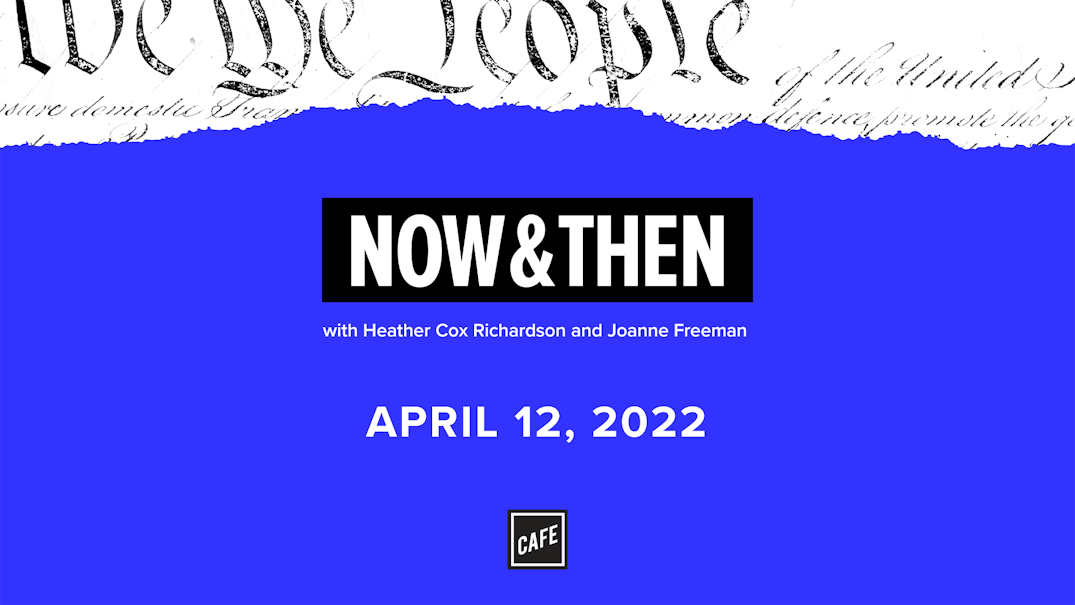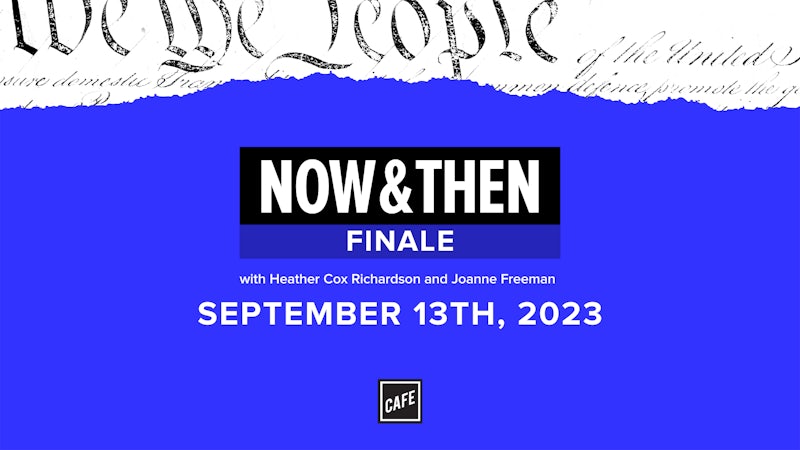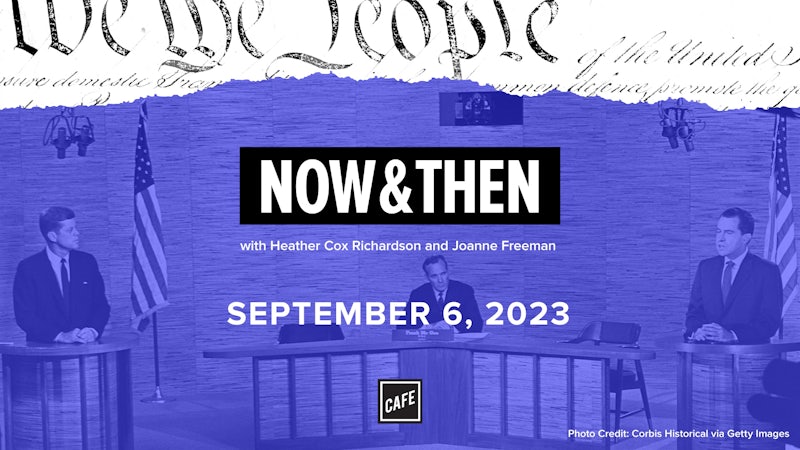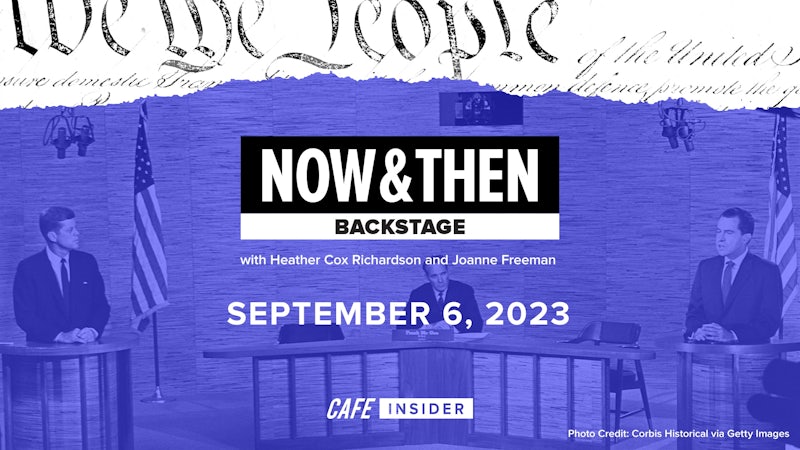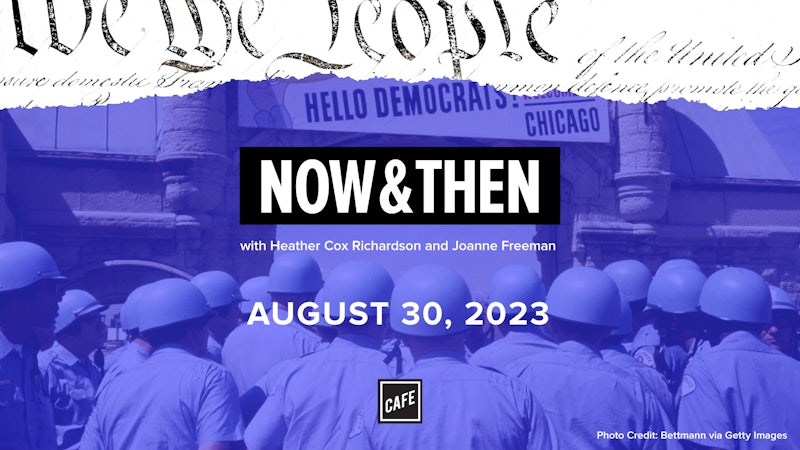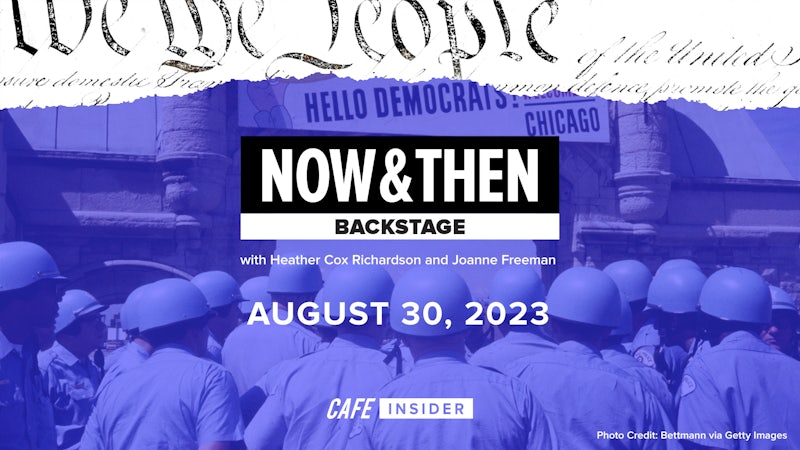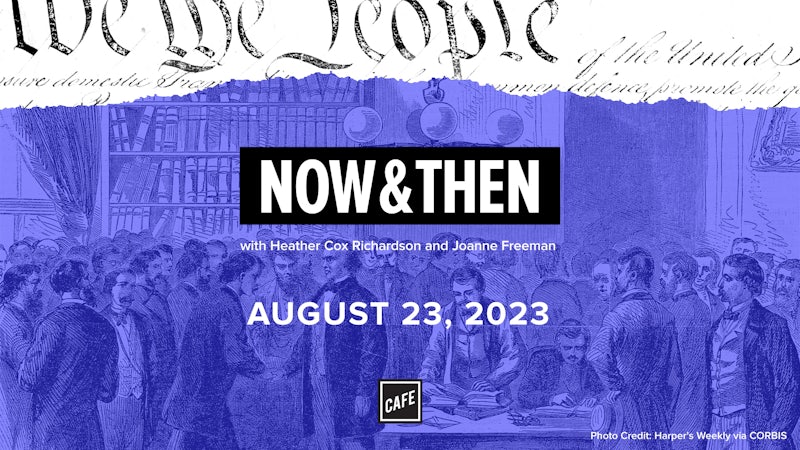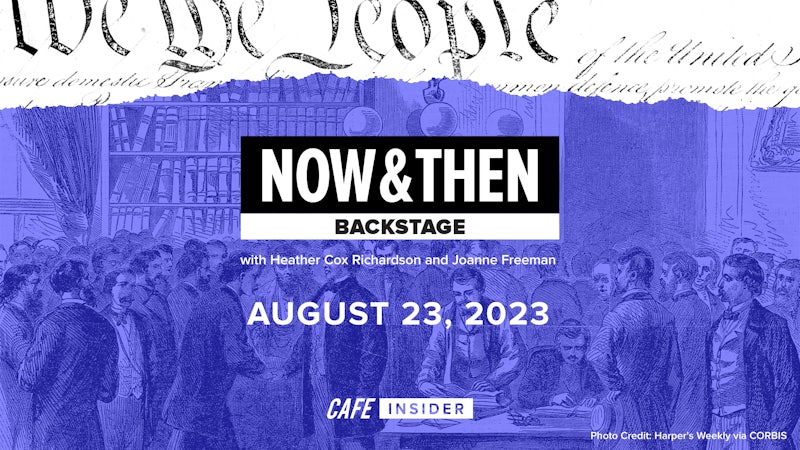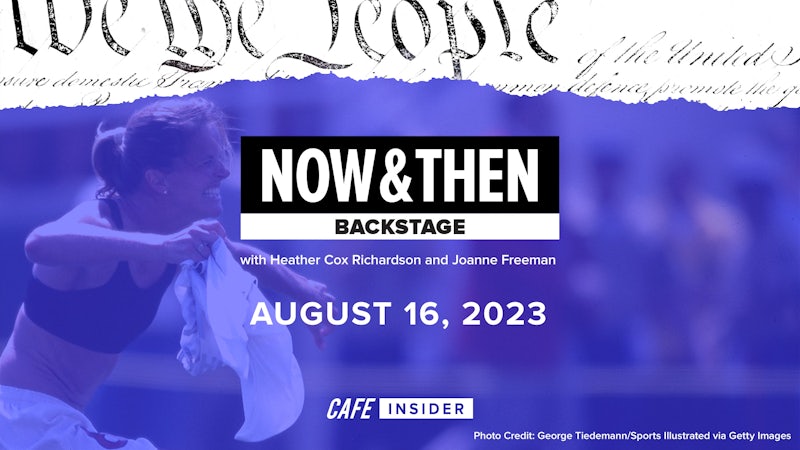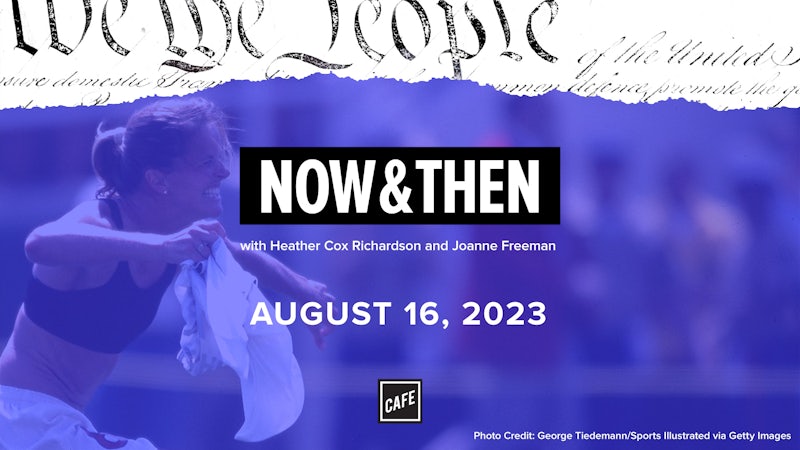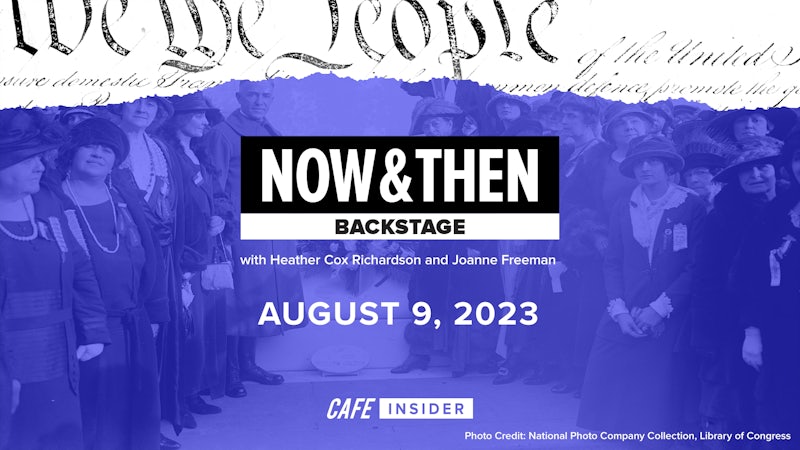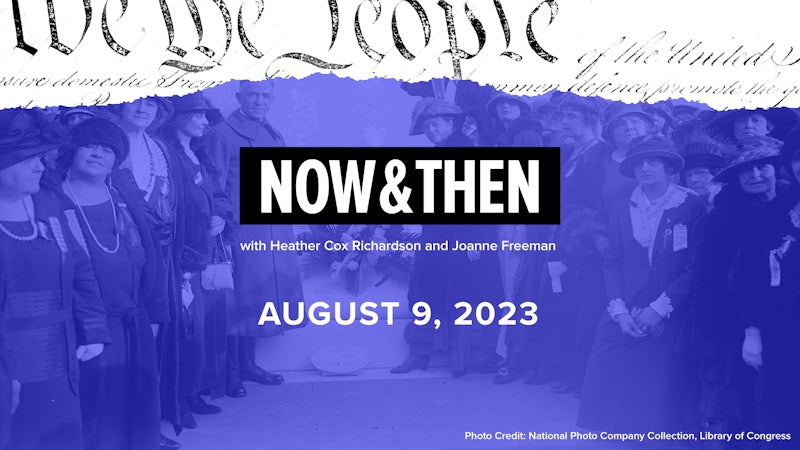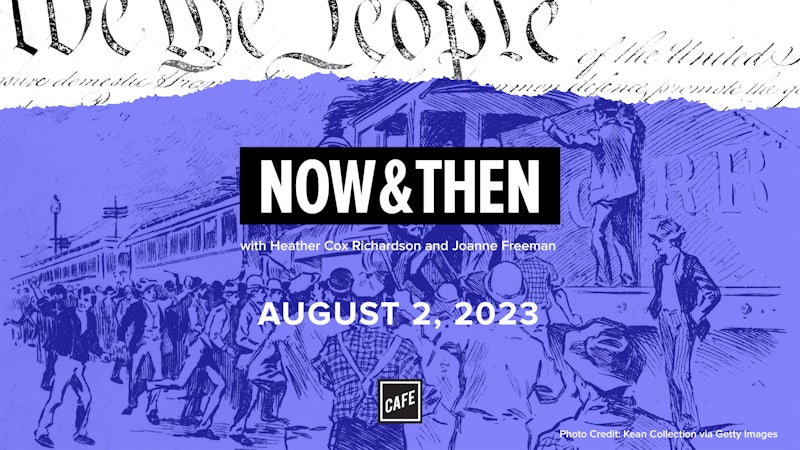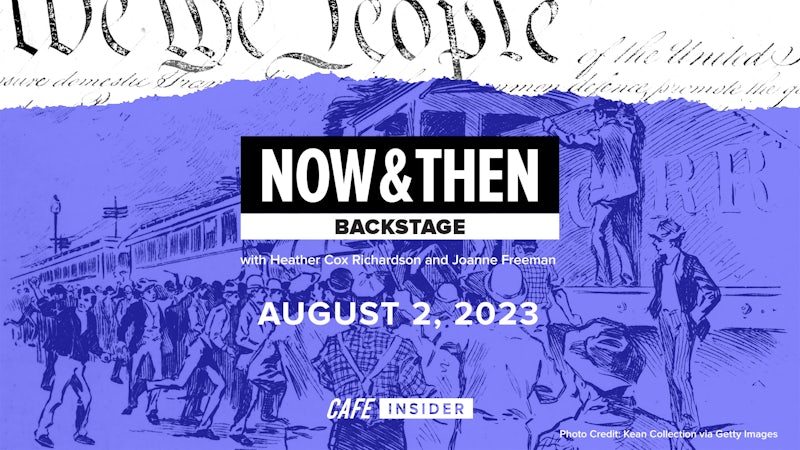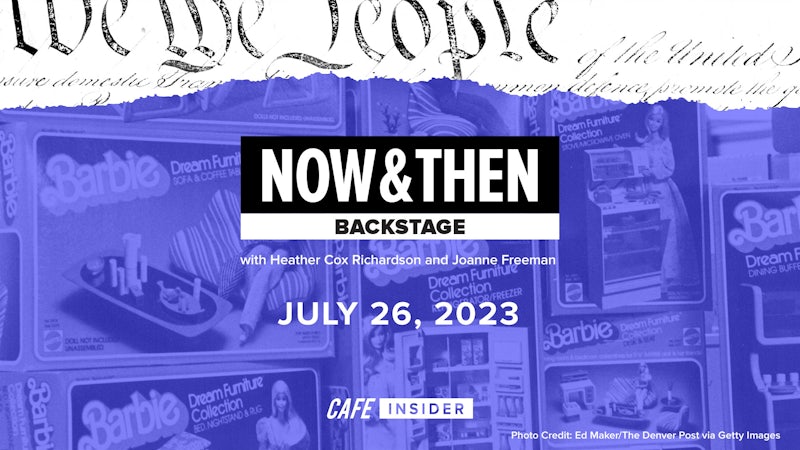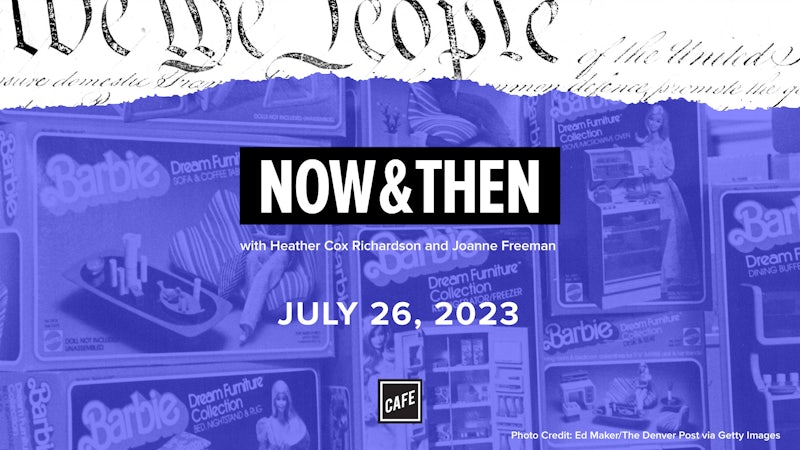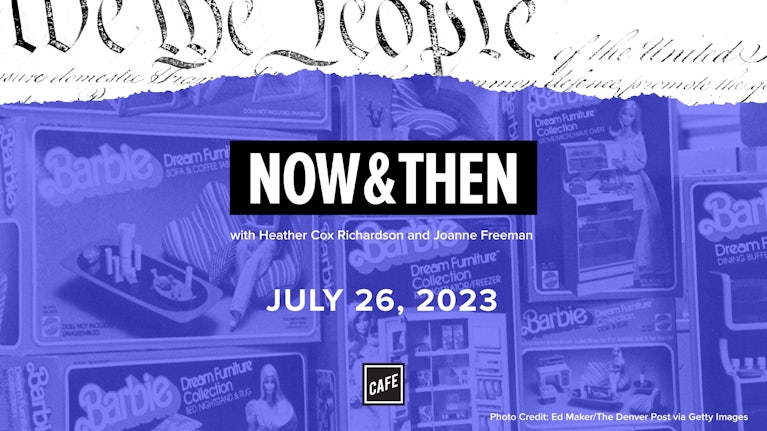Heather Cox Richardson:
From CAFE and the Vox Media Podcast Network, this is Now & Then. I’m Heather Cox Richardson.
Joanne Freeman:
And I’m Joanne Freeman. Today we’re going to be talking about a topic that in one way or another has recently been in the news quite a bit. We’re going to talking about the broader context of LGBTQ issues, LGBTQ identity, and contextualizing some of what we’re seeing now, particularly some of the new attempts at legislation to ban certain kinds of conversations, to brand certain kinds of materials and classrooms.
We’re going to be the looking at how, in the United States, historically speaking, this issue has been addressed, and rather than assuming that at the current moment we are somehow moving back towards some hyper traditional moment that everyone agrees on in the past, we’re going to be, as historians do, complicating that a bit and really looking at how this issue was understood and how it was lived in the past.
Heather Cox Richardson:
This is my big thing, this idea that somehow what we are doing now with these extraordinary numbers of these anti-LGBTQ bills is somehow becoming more traditional again. When in fact, this is a brand new moment in American history and state lawmakers, as of March 1st, had proposed a record 238 bills that would limit the rights of LGBTQ Americans. That’s more than three a day, and about half of them target transgender people specifically. Well, if you need that many new bills, clearly you are creating some kind of new fences.
The other thing that I keep harping on is the political angle of this, and I just want to put on the table before we even get into the history of this, that the modern authoritarian movements, especially that of Vladimir Putin, the President of Russia, garnered support in large part by doubling down on the idea that LGBTQ people were somehow endangering children, and famously in 2013, Putin signed into law a bill that was actually called a bill for the Purpose of Protecting Children from Information Advocating for a Denial of Traditional Family Values.
It became known in the US as the gay propaganda law, and it prohibited the distribution of propaganda of nontraditional sexual relationships among minors, and that included any material that raised interest, any kind of homosexual relationships, or caused minors to form nontraditional sexual predispositions. When he won reelection in Hungary, one of the things that was on the same ballot as Viktor Orban, the authoritarian rising in that country, was a referendum that asked if people were in favor of or against the idea of providing sexually explicit material to small children.
They’re really using the idea of danger to children through LGBTQ, as they call it propaganda, as a way to garner right wing support, and I think that’s a really marker here as we jump back to the way that Americans have traditionally looked at LGBTQ issues.
Joanne Freeman:
It is, and it’s particularly for authoritarian purposes, making this kind of distinction, drawing lines, clear lines, where there aren’t clear lines, making these categories and drawing these judgements. Not all only is that a powerful way of othering people, which in an authoritarian regime, the us and the them is particularly important. But once you are othering people and it’s associated with children, it’s like the most powerful way to other people. It’s like, look, this is something that should draw your emotion. We don’t even have to think about this.
This is something that, if you want to use it, can be very powerful. Politically, regardless of the reality, and part of what we’re going to be talking about here is how we have a tendency on the one hand to make these categorical judgements about good and bad, and we tend to sweep a lot of diversity in the different ways in which people understand gender and sexuality, and to eliminate that, to not see that and assume that there’s something here that you can be angry about because it in and of itself sums up every single thing about sexuality in the current day.
Now, it’s important to say at the outset that what we’re talking about here today is people categorizing other people, particularly for political purpose. We are not saying, in all of our discussion today, about fluidity of gender and sex and ways in which people were more accepted, there was more fluidity in what was allowable in society. Despite the fact that, we’re saying that we’re not meaning to suggest that there wasn’t discrimination, that people weren’t outcast, that there wasn’t violence against people in same sex relationships. All of that is true.
What we’re talking about is the way people categorize other people in the past and what we’re seeing along those lines now. It makes sense that questions of gender and sexuality can be a really powerful political tool generally, particularly makes sense in an authoritarian regime. What we’re going to be seeing in part today as we talk is going to be the many ways in which those kinds of clear categories don’t necessarily apply to the past.
Heather Cox Richardson:
Well, and you and I have done so much with how, when you’re trying to make people think that the society is going to hell on a hand basket, you say, “Oh, look at the children. Look, what’s happening to the children from the Salem witch trials forward.” Let me start, Joanne, by asking you about what gay participation looked like in American society in colonial America and the early republic especially. Of course, you know I’m aiming for one person in particular.
Joanne Freeman:
Right. Alexander Hamilton is going to have a moment. He actually is a great example of the kind of fluidity that we’re talking about here. Partly because as a historical figure, this is not something that necessarily was discussed or acknowledged in any way. But now it actually, partly because of popular culture and partly for other reasons, has become a question that a lot of people ask. Now, in speaking about Hamilton, sometimes they will ask, “Was Alexander Hamilton and his friend, John Laurens, were they buddies or buddy buddies?”
That’s not an easy question to answer because there are many ways you could answer it. In anticipation of this conversation, I actually went online, looked at Google and I thought, “Well, when people ask this question online, what do they get?” To a large extent, what they get is this ongoing conversation. He was gay. No, he’s not. He was gay. No, he’s not. He was gay. No, he’s not. Over and over and over again. Now, in early America, generally people didn’t draw that kind of categorical line.
For one thing, people were more focused on the sexual acts that were homosexual than on identifying people, branding them as homosexual people. They wear a big H on their chest that this was a central part of their identity. Sexual attraction and things that people considered norms or not norms more centered on acts than identity. Now, this isn’t to say that people in early America couldn’t identify themselves as being the kind of person who’s attracted to people of the same sex. That’s fine.
But unlike now, and this is a little hard to get our minds around, unlike now, it wasn’t a big categorical assumption. Let’s talk for a moment about Hamilton. The period when people most focus on this, as far as his sexual identity is concerned, is the revolution. He’s young, he’s 19, roughly, maybe 20, depending on when you think he’s born, and he’s serving as an aid to camp, to Commander in Chief George Washington. Also acting as an aid to camp at that time is a South Carolinian of roughly the same age named John Laurens. The two become very, very close friends.
Speaking as someone who has read the 27 volumes of the Hamilton papers, so I print much know everything that the man has written, I can say that in all of those volumes, the letters that Hamilton writes to John Laurens are unlike any others that he writes. They’re very explicitly loving, they’re vulnerable. Hamilton’s not someone who liked being dependent on anybody, but it’s very clear that in one way or another, emotionally and in a deep personal kind of a way, he needed and wanted John Laurens.
He makes jokes and puns and things that have a sexual innuendo and make it so that if you’re a modern historian and looking at this, you can say, “Oh, well, he was only joking,” or you can say, “No, actually that’s pretty clear what he’s saying.” Hamilton very well could have been in a romantic relationship with Laurens. They could have been lovers. Here is one letter of Hamilton’s to Laurens, which is not unique. There are others like it, but it gives you a sense of the intensity and the emotion of their relationship.
Hamilton writes to Laurens in 1778, “I wish, dear Laurens, it might be in my power, by action rather than words, to convince you that I love you. I shall only tell you that until you bade us Adieu, at headquarters, I hardly knew the value you had taught my heart to set upon you.” That’s moving, and it also can have a multiple meanings, but it’s very intense and it’s speaking about a relationship that matters profoundly to Hamilton. We don’t know what that action means, and it could mean anything, but they clearly had an intimate and very possibly sexual relationship.
There’s another Hamilton quote, which is interesting because it manages to mention within a few sentences Hamilton’s feelings about his wife and his feelings about Laurens, and again, gets at this idea of fluidity that we’re talking about so much in this episode. Hamilton writes to Laurens in 1780 and says, “In spite of Schuyler’s black eyes,” and he means Elizabeth Schuyler, Eliza, “I have still part for the public and another for you, so your impatience to have me married is misplaced, a strange cure by the way, as if after matrimony I was to be less devoted than I am now.” In a sense, you have to hear Hamilton’s own words to understand the depth and the meaning of that relationship.
Heather Cox Richardson:
When you say those are different than any of the other letters he’s written, were they different from the ones he wrote to women, especially his wife?
Joanne Freeman:
Ooh, that’s a good question. Yes, actually, they are a little different, but in a gendered way, meaning letters to his wife or to women have a kind of gallant pose, whereas Hamilton’s letters to Laurens are more graphic and more blunt. The ultimate example of this is a letter, actually, in which he says to Laurens, “Go find me a wife. I need a wife,” and he describes her in a very joking kind of a way. “Well, doesn’t matter what her politics are. I’ll convince her of mine,” and he moves on in that vein.
Then he says, at the end of his description, “And don’t forget to tell her about the size of my nose.” Heather’s eyebrows just went all the way up her far head. In the late 18th century, if you’ve read Laurence Sterne’s Tristram Shandy, there is a whole chapter on noses, which is really a chapter on penises. Nose was very well known to be referring to that male organ when people used it culturally at the time.
Things like that joined, with the emotional tenor and neediness and really just the depth of that relationship, suggests, yeah, it’s totally possible and even probable that Hamilton and John Laurens had some kind of a relationship, romantic relationship, lover relationship like that. Hamilton is a great example of the sort of thing that Heather and I are talking about here as far as not clear categories, as far as people behaving in ways, having same sex relationships, engaging in behavior that today we might call homosexual.
We might brand that kind of person a homosexual person, but that simply wasn’t happening at that time. That label wasn’t being tossed around, that word actually dates to much later in the 19th century. There was a much greater sense of fluidity and less of a need to categorize people, to put people in boxes than we see in modern times.
Heather Cox Richardson:
It’s not unlike the fact that the history books until recently didn’t really talk much about James Buchanan either, who had a long standing relationship with Alabama Senator William Rufus DeVane King from the 1830s. James Buchanan is of course going to be elected president in 1856, and Buchanan and King lived together, they cohabited on and off for more than 16 years until King died in 1853.
The people at the time referred to James Buchanan as Miss Nancy, which was a euphemism for a man who had sexual relations with another man. Buchanan, again, I guess like Hamilton, wrote some pretty explicit letters to King. He at one point wrote, “I envy Colonel King the pleasure of meeting you and would give anything in reason to be of the party for a single week. I am now solitary and alone, having no companion in the house with me.”
“I have gone a wooing to several gentlemen, but have not succeeded with any of them. I feel that it is not good for a man to be alone and should not be astonished to find myself married to some old maid who can nurse me when I am sick, provide good dinners for me when I am well, and not expect from me any very ardent or romantic affection.” Though, in his case, politicians from the opposite party did try and use his relationship with King as a way to attack him, and yet it doesn’t stick. Buchanan does get elected president.
There is widespread consensus that he and King did have an intimate sexual relationship, and yet it was only one aspect of Buchanan’s political career and one aspect of Buchanan. I know that people often don’t define him as being a gay president because he did not identify himself in any way as part of a gay culture. Early on, that fluidity of identity seems to be a key part of American social culture, and one might even call it. I don’t know, Joanne, what do you think? Traditional?
Joanne Freeman:
I actually have scrolled on a piece of paper in front of me that if you’re talking about tradition and having to do with these issues, there’s a pretty long tradition of people engaging in this kind of behavior and in these earlier times not being branded with an identity or category that this fluidity meant that people were engaging in homosexual and same sex activity. It was happening in a lot of places. It’s a little bit harder to find when you’re a historian digging in the record, but it’s certainly there.
There weren’t the sweeping statements about morality being made across the board as though this is something to be assumed as a category of bad, a category of evil. It was just there are different kinds of people who had different kind of relationships with different kinds of other people, and that was the way it was. Now Heather, we’ve been talking pretty much about men up until this point, but there’s a lot to say about women in this category as well. I know you expressed interest when we were trying to figure out what we wanted to talk about. You’re the one who mentioned Boston marriages.
Heather Cox Richardson:
Yeah. I love this whole idea of Boston marriages and what they meant because coming out of the Civil War, women begin to have more opportunities in economics and more opportunities in education, and one of the things that comes out of opportunities for education is that women who’d previously been isolated within their own homes begin to meet other women at women’s colleges and begin to share ideas and to share aspirations and to share profoundly deep friendships, especially for people who are boarding, going off to boarding school.
Those relationships transition into lifelong teams, if you will, in places like settlement houses and in places where women begin to work together to an advance American reform. That’s, of course, really pushed in part by the lack of widespread access to contraception because two women pairing up are not in danger of having babies and are not in danger of having to deal with the burdens of motherhood and also the dangers of pregnancy and childbirth.
There is, in the late 19th century and early 20th century, this concept of Boston marriages. I love this because the term Boston marriages actually comes from Henry James’ 1886 novel, The Bostonians. I was forced, and I’m deliberately using that term, three times in high school to read The Bostonians. I have read The Bostonians three freaking times, I’ve taken exams on The Bostonians, and I never once picked up that two of the lead characters were theoretically a Boston marriage, were lesbians, because that was not something …
Sexuality was just not something that was tying me in knots when they were forcing me to read The Bostonians. Anyway, in The Bostonians, there’s two lead characters that were patterned after Henry James’ sister, Alice, and her relationship with a writer and an educator, Katherine Loring. They had met in the early 1870s. They were a part of a project called The Society to Encourage Studies at Home. They were, again, these reforming women and they had this relationship that James memorialized in The Bostonians.
The most famous was the relationship between the aunt of William Cullen Bryant and her partner, and the reason this becomes famous is because William Cullen Bryant, who is a poet, he’s a patron of the arts, he’s the editor of the New York Post, he’s the guy that they named Bryant Park for, and he in 1843 wrote about his aunt’s relationship with her partner, a woman named Sylvia Drake, and the aunt was named Charity Bryant.
Bryant was at the time a teacher from a Western Massachusetts family, again, one of these literary Bostonians or literary Massachusetts people, and she had met Drake in 1807 when she went to Weybridge ,Vermont when she was in her early 20s. They moved in together and they stayed a couple until Drake died in 1851.
Joanne Freeman:
44 years. They were together as a couple for 44 years.
Heather Cox Richardson:
William Cullen Bryant called attention to his aunt’s relationship with Drake in a letter that was published in the New York Post, in which he highlighted the similarities between their relationship and a heterosexual marriage. He said, “If I were permitted to draw the veil of private life,” which, by the way, he’s going to do in an incredibly public manner for his aunt. But anyway, “If I were permitted to draw the veil of public life, I would briefly give you the singular, and to me, interesting, story of two maiden ladies who dwell in this valley.”
“I would tell you how in their youthful days took each other as companions for life, and how this union, no less sacred to them than the tie of marriage, has subsisted in uninterrupted harmony for more than 40 years.” He goes on to say that people accept that. “I would speak of the friendly relations which their neighbors, people of kind hearts and simple manners seemed to take pleasure and bestowing upon them. But I’ve already said more than I fear they will forgive me for if they should ever meet their eyes, and I must leave the subject.”
Joanne Freeman:
That brings up a really interesting point. When you read about their relationship and you read about the response to it in the somewhat rural area where they were living, people in that area accepted it as just who these people were. There’s an assumption that same sex relationships somehow or other are happening in big cities, and that, again, traditional areas of America, rural areas of America have no patience for that, have no acceptance for that, and certainly, in some cases, in some places, particularly nowadays, that’s true.
But if you’re talking about the first half of the 19th century, people where they lived, you can see them writing about it, speaking about it. These were just two women who, they would say, basically were married and were accepted along those lines.
Heather Cox Richardson:
I love the way you just put that because the other place that I love the intersection of LGBTQ history and American culture is advertising. Historians have really rested a lot on George Chauncey’s Gay New York talking about the establishment between 1890 and 1920 or so of a gay culture in New York divided along the lines of masculinity and femininity, not necessarily in terms of sexual activity. But one of the things we’ve downplayed a little bit is …
At least in the popular sphere, one of the things that people may not know as much about is the fact that a lot of the people who really were the pioneers in the advertising and the illustration industry were LGBTQ. One of my favorites is an illustrator, a guy named J.C. Leyendecker, who redefined the aesthetics of American advertising. This really is your field more than mine, Joanne, but I’ve always loved this guy’s advertising because it was so crisp and so clear, and the lines.
I always love patterns and lines, and his is just so meticulous. He was born in Germany and he was very famous for his magazine come overs in the mid ’20s. He made 48 covers for Collier’s magazine and 322 for the Saturday Evening Post. That was one more than Norman Rockwell. In 1905, he created a character known as the Arrow Man. The Arrow Man was the advertising figure for the Arrow Collar from the Cluett Peabody collar and shirt company.
These are arrow shirts, arrow collars, and the model for that mascot was Leyendecker’s lover, a man named Charles Beach, who was a young model from Cleveland. Beach became the symbol of the ’20s, of early American ’20s, with these gorgeous illustrations. He finds his sway into popular culture. Lots of people think that if Scott Fitzgerald wrote The Great Gatsby that he was referring to the Arrow Collar Man. When Daisy Buchanan said to Jay Gatsby, “You always look so cool. You resemble the advertisement of the man.” The advertisement of the man, and he shows up in a number of plays as well and then, of course, he shows up in Cole Porter’s-
Joanne Freeman:
Broadway hit from 1934, Anything Goes. The song, which a lot of you must know out there, but you might not know this lyric, is You’re The Top. I’d have to be honest that before preparing for this episode, I didn’t know this lyric. (singing) There it is. (singing) Boy. (singing) Okay, I’m sorry. You’re camembert?
Heather Cox Richardson:
Yeah. That’s cheese.
Joanne Freeman:
I know, but why are you cheese? I know it’s a-
Heather Cox Richardson:
Because that’s the best. All these things are best.
Joanne Freeman:
I know, but it’s a stinky cheese. I’m sorry.
Heather Cox Richardson:
Yeah, but it rhymes with Fred Astaire.
Joanne Freeman:
I know.
Heather Cox Richardson:
Camembert rhymes with-
Joanne Freeman:
I know.
Heather Cox Richardson:
… Fred Astaire.
Joanne Freeman:
No.
Heather Cox Richardson:
Come on. They got Arrow Collar into a song.
Joanne Freeman:
Well, exactly, and a with a Coolidge dollar and that rhyme is part of the song. No, I understand why everything’s there. It’s all the top. It’s just every time I think of this and when I read it before just attempting to sing it, you’re camembert, yeah, I know it’s a great cheese. It’s a stinky cheese. This is not my favorite Cole Porter lyric. Let’s just leave it at that.
Heather Cox Richardson:
Okay. I like camembert. With pears, it is excellent. Lay off the camembert.
Joanne Freeman:
Okay. I’m backing away.
Heather Cox Richardson:
The aesthetic of the Arrow Collar Man and advertising in the 1920s is the forerunner of increasingly visible gay culture, especially in the cities. While that is very famous in New York, for example, and begins to be increasingly visible, there is, of course, a backlash against that as well. The increasing visibilities through advertising, for example, and through paintings, and of course, we’ve identified the Arrow Collar Man, but there are plenty more examples in popular culture of this LGBTQ aesthetic becoming more visible, that also becomes more visible, especially in the cities in terms of gay culture and gay clubs.
Joanne Freeman:
There’s enough people there that there’s a collective sense of being gay, and so there can be clubs and centers and places that exist because there’s enough people. There’s the population of people who exist there and can come together.
Heather Cox Richardson:
But one of the things that I find really interesting about this era in America is that the division in terms of LGBTQ versus heterosexual life is not one necessarily of sexual activity, it’s of perceived masculinity or femininity. It is possible, for example, for especially working class men, to have sexual relations with other men so long as they’re perceived to be the masculine person in that relationship.
Sounds like a very unclear definition there, but the dividing line is not sexual relations. The dividing line is perceived masculinity or perceived femininity. Are you acting like a lady or are you not? Are you acting like a man or are you not? The people with whom you have sexual relations may or may not be significant to that masculine-feminine division. The post World War II period is going to rip apart this more fluid understanding of identity in the earlier period.
But one of the things that’s interesting about that is as we get to the moment we’re in now and the increasing sense of otherness that you’ve identified with LGBTQ individuals is that when that first begins after World War II and it’s really at the hands of Senator Joe McCarthy of Wisconsin, at first, he starts to use that language of masculine-feminine. That’s what he’s really wondering about. Are men acting like men?
That’s going to change through the next 50 years when the issue is more the sexual identity of individuals. But I think that transition is really interesting that at first when McCarthy begins to talk about the dangers that America is facing, of course, first he starts talking about communists. But then in 1950, the Deputy Undersecretary of State, a guy named John Peurifoy, testifies that they’re not worried about communists in government.
Heather Cox Richardson:
But they are concerned about homosexual employees and that the State Department had recently thrown out 91 people identified as homosexual because they believe they were security risks, that they would be blackmailed, and therefore they shouldn’t know state secrets because they would have to give them away or be blackmailed, and that speaks, I think, to the backlash against the culture that we were just talking about.
We often focus on the Red Scare in the 1950s, the fear of communist infiltrating American government, but that was happening at the same time as another scare which we know is the Lavender Scare, the idea that somehow America was less secure because LGBTQ people were working in government positions.
Joanne Freeman:
It’s interesting that at moments in time when people feel insecure, when they feel that things are up in the air, when they’re afraid of the nation being infiltrated in some way, that those are moments when it’s really important to categorize people and declare them others.
Heather Cox Richardson:
Yeah, but this is a really interesting moment because why sexual orientation? Really? Where does this come from? One of the things that I think is important here is the degree to which America tried to define itself against what it perceived the USSR to be. At the time, the implication from the American side was that anybody involved with a communist government, the Soviet Union in this case, had erased sex differences, had erased traditional families, had erased all sorts of traditional sexual and social roles in their society. There’s a wonderful book at one point that said, “We knew the Soviet Union wasn’t a good thing for women because all the women that they showed us in America looked like Mrs. Potato Head which-“
Joanne Freeman:
Well, not the Potato Heads again.
Heather Cox Richardson:
Well, exactly. But having conjured up that image in their head, people like the head of the FBI, J. Edgar Hoover and McCarthy, who also had rumors about his own sexuality, by the way, conjured up this idea that for an American to be an American there had to be men and there had to be women, and these lines had to be extremely clear. What’s interesting about that, and of course this is the era of poodle skirts and the idea that Dr. Spock is saying that girls should learn how to bake cookies and boys should learn how to fix cars, and there’s all these extraordinary gender divisions in American society.
But what blows me away about this is so many of the men who are pushing this distinction are themselves part of either gay culture or having sex with other men. That idea suddenly is that they’re really almost defending their own identities saying, “Well, I must be a good American because I’m cracking down on these people who aren’t good Americans.” It’s just interesting that they picked, as one of the othering elements in this period, gender identity.
Joanne Freeman:
Well, it shows you how it really isn’t about gender identity.
Heather Cox Richardson:
Exactly.
Joanne Freeman:
It’s about finding something that can be othered. The Red Scare and the Lavender Scare, those are both ways in which you can institutionalize those kind of othering, right? You can have the FBI tracking people down and looking at who you associate with and trying to uncover subversive elements, whether it’s about Red or Lavender. That becomes something that can be institutionalized, acted on, becoming a part of the political infrastructure in a way.
Heather Cox Richardson:
Well, yes, and it’s in a way of self-reinforcing kind of division of society because McCarthy, for example, first began to talk about what he considered the dangers of LGBTQ people, although he’s talking with epithets. He argues that they are security risks, that because they can be blackmailed or because they are somehow of low moral character, they’re going to give away state secrets. This ties into his idea that the State Department has been infiltrated by communists.
Now you’ve got this idea that communism and sexual identity go hand-in-hand, which again, is just mind boggling considering McCarthy himself was certainly suspected of being much more interested in men than women, and one of his right hand men was Roy Cohn, we’ll talk about. Jay Edgar Hoover, of course, himself had a sexual life that was at least on the edges of the LGBTQ community.
Joanne Freeman:
But it’s interesting because it’s certainly something in a variety of ways that we see today, which is people who themselves are part of a culture or a behavior that they are attacking, which highlights the degree to which a lot of this categorization of people and a lot of this branding of people and a lot of the kind of legislation we’re seeing, in and of itself, it’s not about the behavior, it’s about declaring things American or un-American. It’s about what serves that purpose really well.
If you yourself are engaged in the behavior that you’re condemning, it’s in a way that’s proof of the fact that more than anything else it’s just political and useful and a brand that you can brand people with. It highlights the degree which this kind of topic can be used politically for propaganda purposes with great power because of the emotion bound up with it, because you can talk about subversive things, you can act as though you can’t tell from looking at things what the truth is. It lends itself to the kind of climate and boundary drawing and nationalization and deciding what it is or isn’t us. It works very well as a weapon within that kind of a climate.
Heather Cox Richardson:
The other piece of that, really showed in the 1950s, was that once it becomes, certainly in government, the idea that if you are LGBTQ, you are a danger to the government, government employees, especially, but soon it’s going to trickle down through all levels of society, are desperate to indicate that they are not, in fact, LGBTQ. In the spring of 1953, McCarthy tried to get rid of two of Eisenhower State Department nominees, Eisenhower recently been inaugurated, and he wanted Charles Bohlen to serve as the ambassador to the Soviet Union, and Arthur Vandenberg as secretary of the president.
The Bohlen nomination ran into trouble with McCarthy very quickly because during the Bohlen nomination, an FBI report came out. Ironically, that FBI report had been orchestrated by FBI Director Hoover. But in that report, there was the inclusion of anonymous sources, and one of those anonymous sources said, and I quote, “There is a definite shading in Bohlen’s conversation and in his manner of speech, which indicates effeminacy.” There it is again. He’s not a man enough for us. He was not, in fact, gay. He fought the charges.
Ultimately, he was confirmed by the Senate. The other man folded. He was living with another man, although that was a very common arrangement for bachelors in Washington. But his roommate was picked up by Washington police officers in late 1952 and that was enough to refeed the rumor mill and he realized he couldn’t serve in the administration and he withdrew. But in response to that controversy, Eisenhower signed an executive order in June of 1953, which made what was called sexual perversion a fireable offense.
By October of 1953, just four months after he issued that order, 843 government employees had been fired, allegedly because they were LGBTQ, and another 2,283 had resigned. Now, that goes down from the upper levels of the government into town governments and into schools, where people were forced out of jobs with the accusation, as it were at the time, that they were gay or lesbians. This reaches its zenith finally in June of 1954 when McCarthy learns that the son of one of his fiercest rivals had been arrested for soliciting an undercover officer.
That rival was the Wyoming Senator Lester Hunt. He was, again, very anti-McCarthy and vice versa. McCarthy actually blackmailed Hunt, the father, into declining a second term in the Senate. He so heartbroken, Hunt was, that he shot himself in his Senate office with a rifle. This become the symbol of what accusations of LGBTQ identity in the government can do. Ironically, the man who was most responsible for disseminating and enforcing that executive order was his national security advisor, a man named Bobby Cutler. Bobby Cutler himself was a closeted gay man, and then, of course, McCarthy’s chief council, Roy Cohn, was also gay and he is going to die of AIDS in 1986.
Joanne Freeman:
One of the things that strikes me after this discussion is the degree to which you have legislation and political maneuvering and deployment of charges of homosexuality as a way to attack partisan opponents, and that comes about as you’re talking about in the McCarthy era. But that represents gender identity and sexuality as a weapon and as a tool and not necessarily as a reflection of society and what society is thinking at any given moment.
When you look at things, as I’ve done, like etiquette books that teach you the proper way to behave, when you’re looking at early American etiquette guides, for example, as one does, certainly as I do, it’s tempting to look at them and see them as describing how people behaved, when in fact what they’re doing is describing how some people think people ought to behave. But what’s actually happening in society and what people really think are not reflected on those pages.
Some of what we’re talking about when we’ve been moving into the modern era here has been people drawing lines and making accusations for political purpose, not necessarily an open reflection of what’s going on in the United States, but very much born of a moment and of a partisan need and of a form of effectiveness. It’s a useful tool at a particular moment, which gets us back to where we started, in a sense which is if you’re talking about traditional views of gender identity and sex, you’re talking about fluidity.
It’s the modern era that in a sense brings us a different understanding of it, but it’s not as though all of the United States, all of American history has been in one way and that suddenly in the modern era, there’s been this horrible warping in which people are doing things that have never been done before. Things have always been done. People have behaved in all kinds of ways over the course of American history. What matters and what has been different is how that behavior is categorized and deployed, particularly politically.
Heather Cox Richardson:
Well, this whole idea that there’s a binary in American society. The other one that interests me is this concept of families as heteronormative with the Lego man and the Lego woman and the Lego babies and the Lego dog and the Lego cat sort of thing is such a product of the post World War II period and this moment that we are good. We have sexual roles, we have family roles. We fit into these neat little boxes because we’re not the USSR, and the world has never been that way in America. It’s just never been that way.
Joanne Freeman:
It has never been that way, and when you and I, Heather, talked about this in planning this episode, I brought up the fact that what we’re watching too in a new generation of people, younger generation of people, is that they have a broader, more fluid understanding of sex and gender than their parents do. All of these people coming up, and it doesn’t matter if you allow this in the classroom or not, the fact of the matter is this coming generation has their own understanding of these issues that has a lot more room for a lot more kinds of behavior and less of a need to stamp on your forehead, precisely how you identify.
It’s interesting that the current moment that we seeing in some ways might even be partly a reaction to a different kind of shifting demographic. In this case, it’s a shifting understanding of gender, of sex, that is happening and the kind of restrictive behavior that we’re looking at, maybe an attempt to change it, to stop it, to put the breaks on, but society is going to do what society does ultimately, and this kind of behavior will have mixed impacts.
Heather Cox Richardson:
It’s also interesting, I think, that we are in this conversation going back to Hamilton and Laurens and James Buchanan. We’re not just talking about relationships as being sexual relationships. These are intimate relationships that may or may not involve sexual relations, but they are deep and abiding and loving for all that. That erasure of those profound relationships from our history and our understanding of history since the Cold War, I think it’s been an extraordinary loss, because this categorization of you can only have a partner of the opposite sex is your only outlet for intimate friendships even is, A, not the way the world works, but B, just a terrible loss.
Joanne Freeman:
You’re right. It does rob the past. It robs the past of some of its humanity, it robs the past of some of its complexity, it isolates the past as though there’s this other period, and we do this with all kinds of things, not just gender and sexuality, right? We always talk about a golden age of politics when they were so civilized, and speaking to someone who writes about political violence, nope. There was no golden age. But removing this layer of understanding of just human nature, not for political purposes, but just acknowledging how society works, how people interact and how that interaction can define a time, can shape a nation. That gets cut off. That gets eliminated from our spectrum of understanding if we don’t acknowledge that in our history.












